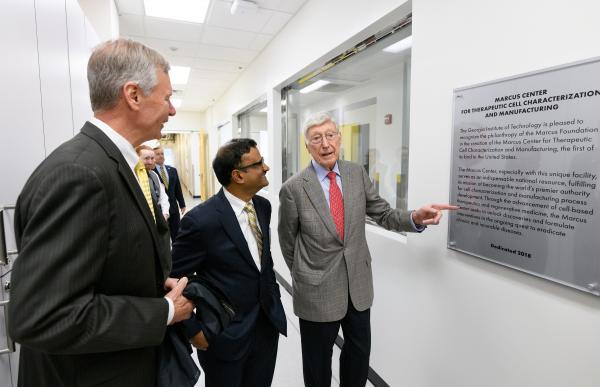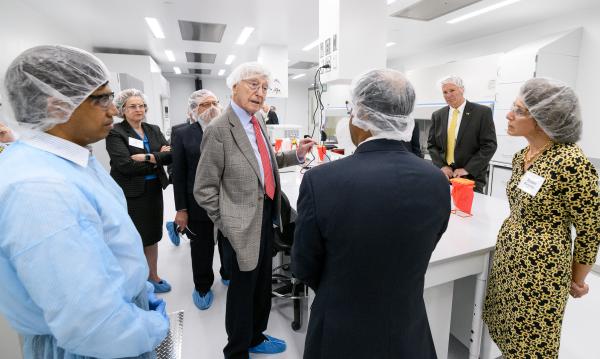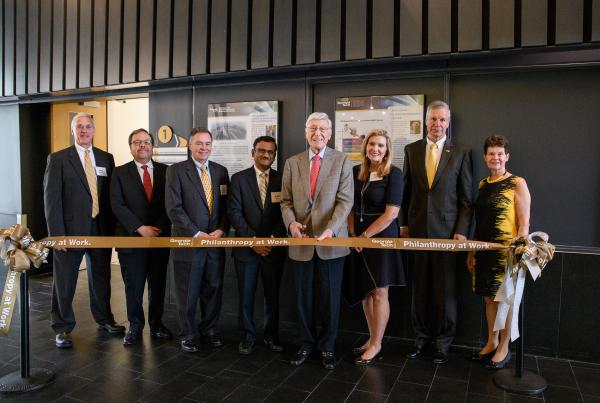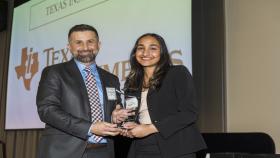The vision of making affordable, high-quality cell-based therapies available to hundreds of thousands of patients worldwide moved closer to reality June 6 with the dedication of a new cell manufacturing research facility at Georgia Tech aimed at changing the way we think about medical therapies.
The new Good Manufacturing Practice (GMP) like ISO 8 and ISO 7 compliant facility is part of the existing Marcus Center for Therapeutic Cell Characterization and Manufacturing (MC3M). The center was established in 2016 and made possible by a $15.75 million gift from philanthropist Bernie Marcus, with a $7.25 million investment from Georgia Tech and another $1 million from the Georgia Research Alliance.
MC3M is already helping researchers from Georgia Tech and partner organizations develop ways to provide therapeutic living cells of consistent quality in quantities large enough to meet the growing demands for the cutting-edge treatments. The center and this new facility also provide the infrastructural foundation for the Georgia Tech-led National Science Foundation Engineering Research Center for Cell Manufacturing Technologies (CMaT), which was announced in September 2017.
The Marcus Foundation’s gift along with the NSF’s expected funding over ten years in CMaT, together with potential private-sector contributions and the state of Georgia’s investment in infrastructure related bio manufacturing, could result in a combined statewide investment of more than $70 million in cell manufacturing. Beyond developing technologies to help make these life-saving cell therapies broadly available and affordable, the initiative will also help train the specialized workforce needed to manufacture these therapies at large scale.
“This initiative has the potential to change the way we think about medical treatments, to change the way we think about medicine, and the way we approach cures for different diseases,” said Georgia Tech President G.P. “Bud” Peterson, who opened the dedication event. “Here, we will develop the tools and technologies to produce these cells at lower cost, more rapidly and for more people.”
MC3M is already supporting 23 research projects aimed at all components of the challenge, from understanding cell quality and developing scalable processes, to chip-based disease models for safety and efficacy testing and new models for supply-chain optimization and logistics. The center collaborates with several other institutions, supporting the work of 29 faculty members, and helping train 27 students and fellows for the emerging cell manufacturing industry.
The new facility dedicated on June 6 is a unique “sandbox” for collaboration among engineers, clinicians, and industry to develop and validate new scalable manufacturing processes for cell therapies under GMP conditions necessary to eventually obtain regulatory approvals. It will serve as the translational arm of the Marcus Center and CMaT to help researchers throughout the state of Georgia translate emerging cell therapies to clinical practice. This facility – designed to enable real time quality monitoring and control of cell products during manufacturing – is a one-of-a-kind space that will be instrumental in bringing affordable cell therapies to patients faster.
The new cell-based therapies being approved for use in humans can have dramatic impact. But the therapies are costly, as much as a $500,000 per patient. The MC3M will help develop new technologies and processes to make these treatments consistent in quality and available to the average person.
“The center is about providing access for patients and enabling patients to benefit from these incredible therapies that could change their lives,” said Krishnendu Roy, who directs both MC3M and CMaT. “We need to scale these therapies up to treat hundreds of thousands of patients. This is the vision of Mr. Marcus – to make this available to everyone regardless of their socio-economic status.”
Marcus, who recalled working as a pharmacist before co-founding home improvement retailer The Home Depot, noted that common drugs such as aspirin are chemically consistent around the world, regardless of where they are sold. The consistency of living cell therapies can’t be similarly counted on because their properties may depend on the specific skills and facilities of the research center producing them.
“Patients receiving these cells need to know that they are getting the right things,” Marcus said. “This is a very practical question for which we have no answer now.” Beyond consistency, the cells also need to be affordable, he said.
The new cell manufacturing facility will connect cell-based therapies being developed in research facilities with the appropriate tools and technologies that ensure consistency in manufacturing and product quality while enabling scalability. “There is a gap right now between what we do in the research lab and what we need to do to get these therapies to a hundred thousand or even millions of patients,” Roy noted.
Beyond developing quality control and analytical techniques to ensure consistency, the center will also develop novel feedback-controlled automation systems to lower the cost, Roy said.
Peterson noted the potential economic impact of building a cell manufacturing industry in Georgia. “Working with our partner universities, the Technical College System of Georgia and the private sector, we will be able to attract new industries, create new jobs and help build the economy of the state of Georgia.”
The initiative began, he noted, with the development of a national cell manufacturing roadmap, an effort supported by the National Institute of Standards and Technology (NIST). The Marcus gift built on that foundation, and in turn, made it possible for Georgia Tech to lead a team including the University of Wisconsin, University of Georgia, University of Puerto Rico-Mayaguez, and other partners, to win the NSF Engineering Research Center award last fall.
Other collaborators in Georgia include Emory University and Children’s Healthcare of Atlanta.
The NSF ERC could provide up to $40 million over ten years, and attract private and local investment that could boost that amount much higher.
“We have incredible momentum,” Roy said. “We are bonded together by a single goal: getting these therapies to many patients at a lower cost to really help them.”
Research News
Georgia Institute of Technology
177 North Avenue
Atlanta, Georgia 30332-0181 USA
Media Relations Contact: John Toon (404-894-6986) (jtoon@gatech.edu).
Writer: John Toon
Media Contact
John Toon
Research News
(404) 894-6986
Keywords
Latest BME News
Jo honored for his impact on science and mentorship
The department rises to the top in biomedical engineering programs for undergraduate education.
Commercialization program in Coulter BME announces project teams who will receive support to get their research to market.
Courses in the Wallace H. Coulter Department of Biomedical Engineering are being reformatted to incorporate AI and machine learning so students are prepared for a data-driven biotech sector.
Influenced by her mother's journey in engineering, Sriya Surapaneni hopes to inspire other young women in the field.
Coulter BME Professor Earns Tenure, Eyes Future of Innovation in Health and Medicine
The grant will fund the development of cutting-edge technology that could detect colorectal cancer through a simple breath test
The surgical support device landed Coulter BME its 4th consecutive win for the College of Engineering competition.










